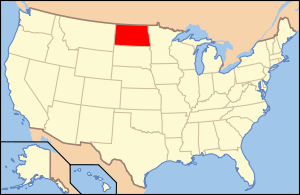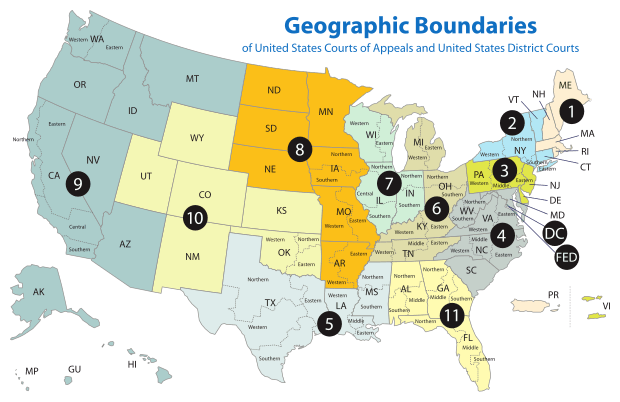United States District Court for the District of North Dakota
| United States District Court for the District of North Dakota | |
|---|---|
| (D.N.D.) | |
 | |
| Location | Bismarck |
| Appeals to | Eighth Circuit |
| Established | November 2, 1889 |
| Judges | 2 |
| Chief Judge | Daniel L. Hovland |
| Officers of the court | |
| U.S. Marshal | Dallas L. Carlson |
|
www | |
The United States District Court for the District of North Dakota (in case citations, D.N.D.) is the United States District Court or the Federal district court, whose jurisdiction is the state of North Dakota. The court is headquartered out of Bismarck at the William L. Guy Federal Building and has additional locations at Fargo, Grand Forks, and Minot. The district was created in 1889, when the Dakota Territory was divided into North Dakota and South Dakota. The Grand Forks courts are located at the Ronald N. Davies Federal Building and U.S. Courthouse.
In 1921, a second temporary judgeship was authorized, however, this was never made permanent and the judgeship expired in 1928. In 1954, a second permanent judgeship was authorized, and the strength of the court has remained unchanged since.
The United States Attorney's Office for the District of North Dakota represents the United States in civil and criminal litigation in the court. Christopher C. Myers is the United States Attorney for the District of North Dakota. Appeals from the Court are heard by the United States Court of Appeals for the Eighth Circuit (except for patent claims and claims against the U.S. government under the Tucker Act, which are appealed to the Federal Circuit).
Current judges
| # | Title | Judge | Duty station | Born | Term of service | Appointed by | ||
|---|---|---|---|---|---|---|---|---|
| Active | Chief | Senior | ||||||
| 11 | Chief Judge | Daniel L. Hovland | Bismarck | 1954 | 2002–present | 2016–present 2002–2009 |
— | G.W. Bush |
| 13 | District Judge | vacant | — | — | — | — | — | — |
| 9 | Senior Judge | Patrick Anthony Conmy | inactive | 1934 | 1985–2000 | 1985–1992 | 2000–present | Reagan |
Vacancies and pending nominations
| Seat | Seat last held by | Vacancy reason | Date of vacancy | Nominee | Date of nomination |
|---|---|---|---|---|---|
| 2 | Ralph R. Erickson | Elevation | October 12, 2017 | – | – |
| 1 | Daniel L. Hovland | Senior Status | November 10, 2019[1] | – | – |
Former judges
| # | Judge | State | Born–died | Active service | Chief Judge | Senior status | Appointed by | Reason for termination |
|---|---|---|---|---|---|---|---|---|
| 1 | Alfred Delavan Thomas | ND | 1837–1896 | 1890–1896 | — | — | B. Harrison | death |
| 2 | Charles Fremont Amidon | ND | 1856–1937 | 1896[2]–1928 | — | 1928–1937 | Cleveland | death |
| 3 | Andrew Miller | ND | 1870–1960 | 1922–1941 | — | 1941–1960 | Harding | death |
| 4 | Charles Joseph Vogel | ND | 1898–1980 | 1941–1954 | 1954 | — | F. Roosevelt | appointment to 8th Cir. |
| 5 | Ronald Davies | ND | 1904–1996 | 1955–1971 | — | 1971–1996 | Eisenhower | death |
| 6 | George Scott Register | ND | 1901–1972 | 1955–1971 | 1955–1971 | 1971–1972 | Eisenhower | death |
| 7 | Paul Benson | ND | 1918–2004 | 1971–1985 | 1971–1985 | 1985–2004 | Nixon | death |
| 8 | Bruce Marion Van Sickle | ND | 1917–2007 | 1971–1985 | — | 1985–2007 | Nixon | death |
| 10 | Rodney Scott Webb | ND | 1935–2009 | 1987–2001 | 1993–2001 | 2001–2009 | Reagan | death |
| 12 | Ralph R. Erickson | ND | 1959–present | 2003–2017 | 2009–2016 | — | G.W. Bush | appointment to 8th Cir. |
Chief judges
Chief judges have administrative responsibilities with respect to their district court. Unlike the Supreme Court, where one justice is specifically nominated to be chief, the office of chief judge rotates among the district court judges. To be chief, a judge must have been in active service on the court for at least one year, be under the age of 65, and have not previously served as chief judge. A vacancy is filled by the judge highest in seniority among the group of qualified judges. The chief judge serves for a term of seven years or until age 70, whichever occurs first. The age restrictions are waived if no members of the court would otherwise be qualified for the position.
When the office was created in 1948, the chief judge was the longest-serving judge who had not elected to retire on what has since 1958 been known as senior status or declined to serve as chief judge. After August 6, 1959, judges could not become or remain chief after turning 70 years old. The current rules have been in operation since October 1, 1982.
Succession of seats
|
|
|
| ||||||||||||||||||||||||||||||||||||||||||||||||||||
See also
Notes
- ↑ Future Judicial Vacancies
- ↑ Recess appointment; formally nominated on December 8, 1896, confirmed by the United States Senate on February 18, 1897, and received commission on February 18, 1897.
